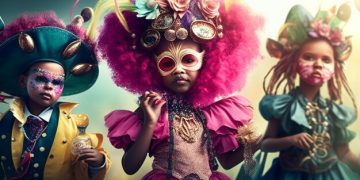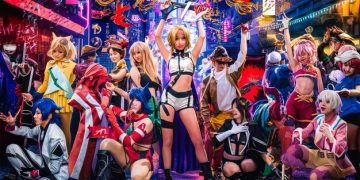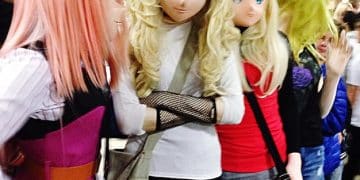Ultimate Guide to Cosplay: Bringing Your Favorite Characters to Life
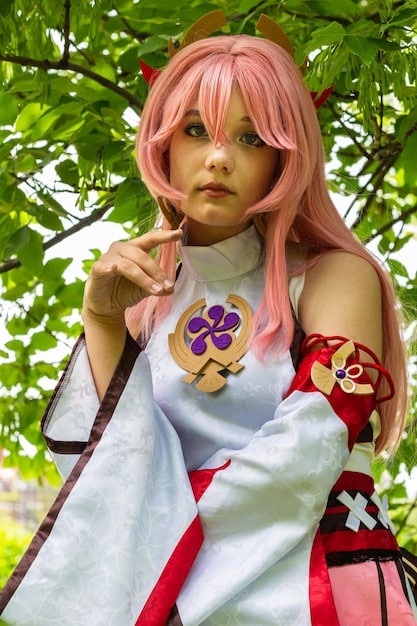
Cosplay, short for “costume play,” is a vibrant subculture where enthusiasts embody their favorite characters from video games, anime, comics, and more, showcasing meticulous craftsmanship and passionate performance to bring fictional worlds to life.
Dive into the captivating world of cosplay, where creativity knows no bounds and imagination takes center stage. Whether you’re a seasoned veteran or a curious newcomer, this guide will provide you with the essential knowledge and inspiration to embark on your own cosplay journey. Let’s explore the art of bringing characters to life, one costume at a time.
What is Cosplay? A Deep Dive into the Costume Play Phenomenon
Cosplay, a portmanteau of “costume” and “play,” is more than just dressing up; it’s an expressive art form. It involves crafting and wearing costumes to represent specific characters from various forms of media. But what truly sets cosplay apart is the dedication and passion cosplayers invest in embodying the spirit and personality of their chosen characters.
It’s a unique blend of craftsmanship, performance, and community, offering a sense of belonging and a creative outlet for people of all ages and backgrounds. Let’s delve deeper into the origins, evolution, and cultural impact of this fascinating phenomenon.
The Origins and Evolution of Cosplay
While the modern concept of cosplay is often attributed to Japanese anime and manga culture, its roots can be traced back to early science fiction and fantasy conventions in the United States. Fans would dress up as their favorite literary characters, showcasing their enthusiasm and creativity.
However, it was in Japan, particularly at events like Comiket, where cosplay truly blossomed. The intricate costumes and elaborate performances became a hallmark of the event, attracting cosplayers and photographers from around the world.
- Early Influences: Science fiction and fantasy conventions in the US.
- Japanese Boom: Comiket in Japan as a major catalyst.
- Global Phenomenon: Spread to global conventions and online communities.
- Technological Advances: Impact of the internet and social media in sharing and documenting cosplay.
The internet and social media played a crucial role in popularizing cosplay globally. Cosplayers could now share their creations with a wider audience, connect with fellow enthusiasts, and learn new techniques from around the world.
In conclusion, cosplay has evolved from niche gatherings to a global phenomenon, fueled by creativity, technology, and a passionate community.
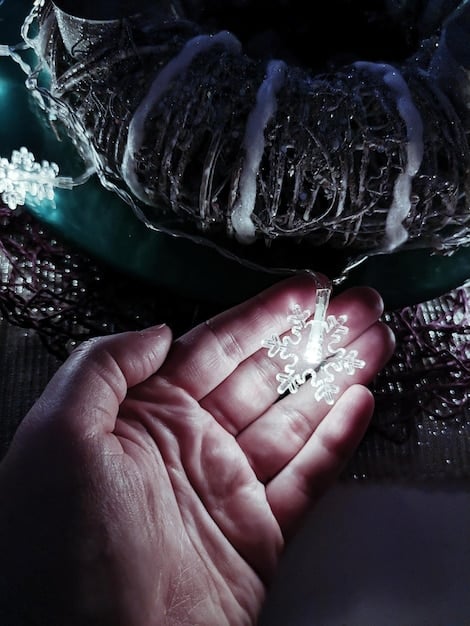
Getting Started with Cosplay: A Beginner’s Guide
So, you’re intrigued by the world of cosplay and want to try it yourself? That’s fantastic! Getting started can seem daunting, but with a bit of guidance and a lot of enthusiasm, you’ll be transforming into your favorite characters in no time. This section will cover the basics, from choosing a character to crafting your first costume.
Let’s break down the process into manageable steps, making your initiation into the cosplay community both enjoyable and rewarding.
Choosing Your First Character
Selecting the right character is a crucial first step. Consider your skill level, budget, and personal preferences. Start with a character whose costume aligns with your abilities and resources. Don’t feel pressured to tackle something too complex right away.
Think about characters you genuinely love and connect with. This passion will fuel your motivation and make the entire process more enjoyable.
Essential Tools and Materials
Before you start building your costume, gather the necessary tools and materials. These will vary depending on the complexity of your project, but some essentials include:
- Sewing Machine: For fabric-based costumes.
- Craft Foam: Versatile material for armor and props.
- Hot Glue Gun: Essential for bonding various materials.
- Paints and Finishes: For detailing and weathering.
RememberSafety first: Always use protective gear when working with power tools or potentially hazardous materials. Proper ventilation is also essential when painting or using adhesives.
In summary, starting with cosplay involves carefully selecting a character, gathering essential tools, and prioritizing safety.
Cosplay Construction Techniques: From Sewing to 3D Printing
Constructing a cosplay costume involves a diverse range of techniques, from traditional sewing to modern methods like 3D printing. The specific methods you use will depend on the character you’re portraying and the materials you’re working with. This section will explore some of the most common and effective cosplay construction techniques.
Mastering these techniques will empower you to bring even the most intricate designs to life, enhancing the authenticity and visual appeal of your cosplay.
Sewing Fundamentals for Cosplay
Sewing is a fundamental skill for many cosplay projects. Whether you’re creating fabric-based costumes or adding details to armor, knowing how to sew can significantly expand your creative possibilities. Start with basic stitches and gradually progress to more advanced techniques.
Practice makes perfect, so don’t be discouraged if your first attempts aren’t flawless. There are countless online tutorials and resources to help you improve your sewing skills.
Working with Craft Foam
Craft foam is a versatile and affordable material widely used in cosplay for creating armor, props, and other structural elements. It’s lightweight, easy to cut, and can be shaped with heat. Experiment with different types of foam to find the best fit for your project.
- Cutting and Shaping: Use sharp blades and heat guns.
- Sealing and Priming: Prepare foam for painting.
- Detailing: Create intricate designs with carving tools.
- Finishing: Achieve realistic textures with paints and weathering techniques.
Rememberthat proper ventilation is crucial when working with heat guns and certain adhesives. Always work in a well-ventilated area to avoid inhaling harmful fumes.
Ultimately, mastering cosplay construction techniques such as sewing and working with craft foam is crucial for creating authentic and visually appealing costumes.
Accessorizing Your Cosplay: Wigs, Makeup, and Props
No cosplay is complete without the right accessories. Wigs, makeup, and props can elevate your portrayal from a simple costume to a captivating transformation. These elements add depth, detail, and authenticity to your character, enhancing the overall impact of your cosplay.
Let’s delve into the world of cosplay accessories and learn how to use them effectively to bring your characters to life.
Selecting and Styling Wigs
Wigs are an essential part of many cosplays, especially for characters with distinctive hairstyles. Choosing the right wig involves considering color, style, and fiber type. Learn basic wig styling techniques to achieve the desired look.
Practice styling your wig before the convention to ensure you’re comfortable with the process and the final result.
Makeup Techniques for Cosplay
Makeup is a powerful tool for transforming your appearance and embodying your chosen character. Learn basic makeup techniques such as contouring, highlighting, and eye makeup application. Experiment with different products and colors to achieve the desired effect.
- Foundation and Concealer: Create a smooth canvas.
- Contouring and Highlighting: Define facial features.
- Eye Makeup: Enhance eyes with color and shape.
- Special Effects Makeup: Add details like scars or wounds.
Always use high-quality makeup products to avoid skin irritation or allergic reactions. Test new products on a small area of your skin before applying them to your entire face.
In summary, accessorizing with wigs, makeup, and props is crucial for enhancing the authenticity and visual impact of your cosplay.

Cosplay Etiquette and Community Guidelines
Cosplay is not just about the costumes; it’s also about the community. Understanding and adhering to cosplay etiquette and community guidelines is essential for creating a positive and inclusive environment. Respect for fellow cosplayers, photographers, and convention attendees is paramount.
Let’s explore the unspoken rules and best practices that contribute to a vibrant and respectful cosplay community.
Respecting Personal Space and Consent
Always ask for permission before taking someone’s photo or touching their costume. Respect people’s boundaries and be mindful of personal space. Not everyone wants to be touched or photographed, so it’s crucial to respect their wishes.
If someone declines a photo request, accept their decision graciously and move on. Harassment or unwanted attention is never acceptable in the cosplay community.
Handling Costume Issues Gracefully
Costume malfunctions are a common occurrence in cosplay. Be prepared for minor repairs and bring a small repair kit with you to conventions. If you notice someone else’s costume is damaged, offer assistance if appropriate.
- Pack a Repair Kit: Include sewing supplies, glue, and safety pins.
- Offer Assistance: Help fellow cosplayers with minor fixes.
- Stay Calm: Don’t let costume issues ruin your experience.
- Respect Others: Be mindful of crowded spaces and avoid bumping into people.
Ultimately,adhering to cosplay etiquette and community guidelines is crucial for fostering a respectful and inclusive environment.
Cosplay Photography and Showcasing Your Work
Capturing your cosplay in stunning photographs is a rewarding way to showcase your hard work and creativity. Whether you’re working with a professional photographer or taking selfies, understanding basic photography principles can significantly enhance the quality of your images.
Let’s explore the art of cosplay photography and discover how to create visually compelling images that capture the essence of your character.
Working with Photographers
Collaborating with a skilled photographer can elevate your cosplay photography to new heights. Look for photographers who specialize in cosplay photography and have a portfolio that resonates with your style. Discuss your vision for the shoot and provide references to ensure you’re both on the same page.
Be open to suggestions and trust the photographer’s expertise. They can offer valuable insights into posing, lighting, and composition that will enhance the final result.
Self-Photography Tips
If you prefer to take your own photos, there are several techniques you can use to improve your results. Use natural lighting whenever possible and experiment with different angles and poses. Invest in a good tripod and remote shutter to avoid blurry photos.
- Natural Lighting: Shoot outdoors during golden hour.
- Posing: Research character poses and practice.
- Composition: Use the rule of thirds for balanced shots.
- Editing: Enhance colors and correct imperfections.
Finally,showcasing your work through cosplay photography is a rewarding way to share your creativity and connect with the community.
| Key Points | Brief Description |
|---|---|
| 🎭 Cosplay Definition | Cosplay is costume play where enthusiasts dress up as characters from fiction. |
| 🛠️ Crafting Techniques | Techniques include sewing, foam crafting, and 3D printing to create costumes. |
| 📸 Photography | Cosplay photography helps showcase the cosplayer’s work and character portrayal. |
| 🤝 Community Etiquette | Respect personal space, ask for consent, and handle costume issues with grace. |
FAQ About Cosplay
▼
Cosplay is a portmanteau of the words “costume” and “play.”
▼
No, cosplay is for anyone who enjoys dressing up as characters, regardless of skill level.
▼
Essential materials include fabric, craft foam, glue, paints, and a sewing machine.
▼
Always ask for permission before taking a photo, and respect the person’s decision if they decline.
▼
Carry a small repair kit with sewing supplies, glue, and safety pins for quick fixes.
Conclusion
In conclusion, cosplay is a captivating blend of creativity, craftsmanship, and community. From its humble beginnings in science fiction conventions to its current status as a global phenomenon, cosplay continues to inspire and connect people through a shared love of characters and storytelling. Whether you’re a seasoned cosplayer or just starting out, the world of cosplay offers endless opportunities for self-expression, friendship, and unforgettable experiences.
